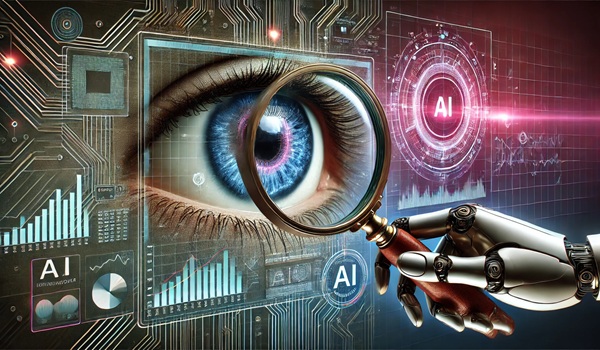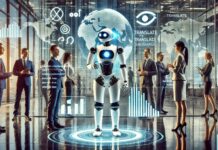Each week we find a new topic for our readers to learn about in our AI Education column.
Today on AI Education we’re going to tackle the concept of artificial intelligence observability—and before your eyes glaze over, I know it sounds about as interesting as watching paint dry, but it’s actually rather thought provoking. AI observability both describes the application of artificial intelligence to the concept of software observability, and the application of observability to AI.
That leads us to observability itself, which according to Google is the ability to understand a system’s internal state by examining its external outputs. A software’s internal state is simply what is going on inside the system while it is operating, including the data it is using and the processes it is subjecting that data to. External outputs describe the stuff that a system emits. Think of a human body. In most cases, it’s not desirable to open up a human body to figure out what’s going on inside of it—it’s not desirable to subject bodies to radiation in the form of X-rays or CT scans, either. Instead, a set of metrics are recorded, including your weight, pulse, blood and urine chemistry and temperature, to make inferences about what is going on inside your body. As it turns out, we do the same thing with software.
As it turns out, we might actually take the temperature of a computer to figure out what’s going on, but, more useful to software engineers are what are known as telemetry or MELT data: Metrics, Events, Logs and Traces. Metrics show a system’s operational state while it is doing something and would include measures like CPU and memory usage, network speed and response time. Logs are records of events within a system offering insight into behaviors and anomalies. Traces follow the flow of individual requests or transactions throughout a system. Events reflect occurrences or changes within a system.
MELT data tell developers what their software is really doing and how well it is doing it. Software observability, in general, helps developers monitor performance, troubleshoot problems, build more reliable software, make better decisions on how to develop or update software, and develop updates and new software more quickly. Traditional software is usually deterministic, everything that happens is a chain reaction initiated by one or more user inputs, and one input if repeated will result in the same output, which makes finding the root cause of problems and failures a relatively simple, step-by-step process. But today’s software is quite different.
Why Observability Is Harder
Let’s take a deep breath: Software is doing more things. Software is connecting with more software. There are different types of technology integrating different pieces of software. Software is using more data. Speaking of more data, Data is being called from different sources. Data is flowing back and forth between different pieces of software. Today’s software is increasingly using unstructured and unstandardized data rather than prepared, structured data. Intersecting compliance regimes are being used.
All of these trends towards more complexity have been present in software development for decades. Now, amid all of this, we also have to contend with complex, modern artificial intelligence software like large language models, which introduce a host of new complexities in need of observability.
AI has impacted observability from two different directions—one, we’ve already alluded to, is that AI has made observability increasingly difficult, to the point that traditional observability solutions will not serve moving forward. However, AI is software and it should be treated like software—and thus it should be observable. Two, rather luckily, is that artificial intelligence’s ability to sift through large amounts of data quickly and rapidly generate recommendations and responses to problems is changing the game in observability.
AI the Problem
Thanks to AI, instead of software producing deterministic outputs where one input, if repeated, results in the same output, outputs are increasingly probabilistic. As a result, the same input may result in different outputs—and it’s not always immediately clear why. Thanks to the more recent iterations of AI, software is also now optimizing itself and synthesizing different pieces of data to generate new data, an output may look very different from the inputs that generated it, which makes it difficult for users and developers to know when an AI model hallucinates.
In other words, the traditional MELT data can’t tell the whole story about what’s happening inside the software. Even so-called “open” AI models are difficult to observe because they are dynamic and continuously evolving.
Enter AI observability.
AI the Solution
AI observability monitors the behavior and performance of AI systems in real-time, using AI’s ability to digest large amounts of data rapidly. If it sounds familiar, it should be: AI observability is a key component of explainable AI, a necessary prerequisite for AI deployment in highly regulated industries like finance. Compared to traditional observability, AI offers developers more predictive insights and the ability to automate many troubleshooting and bug fixing tasks
AI observability can provide visibility into model performance over time—how the model behavior is changing, and if there is an error or a problem with model behavior, where and how it developed and what may be done to correct it. It includes insights into model accuracy, prediction latency (the time between user input and model output) and the ability of the system to find and retrieve data.
AI observability results in the ability to detect (and often measure) data skew (the difference between the operational data used by a model and the data it was trained on), bias and the need for retraining. It enables developers to ensure that AI systems are reliable and robust, allowing them to reduce AI hallucinations, mitigate risks and optimize efficiency and accuracy over time.
Why is it important
Let’s underscore this one more time: Artificial intelligence moves obsevability for all systems, AI and pre-AI systems, into real time, allowing for more proactive changes and faster responses. We’re no longer waiting for a report or a printout (and yes, I’m that old) to tell us what went wrong.
Furthermore, AI observability allows AI to know itself.
LLM and compound AI observability is a new and evolving space, growing alongside the development of artificial intelligence itself. There is no one set of best practices for how to implement observability in a large language model, the telemetry can be radically more complex and different from that returned by traditional software, in addition to being more voluminous.
But what it means is that businesses and developers can monitor the key performance indicators of their AI models in real time, helping them to become more efficient and develop a better user—and customer—experience. Observability allows IT teams to respond to problems faster by eliminating black boxes. It allows businesses and leaders to know how and why things happen with their software. And in the most modern applications of AI, observability also makes possible the continuous improvement of a model in real time.







